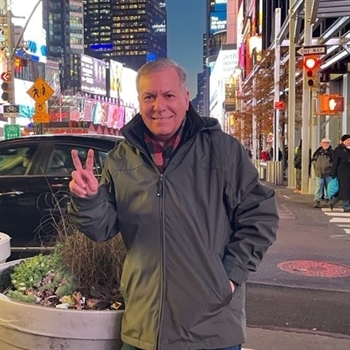Jose Santos
Despite Delays in Care Due to COVID, Retina Specialist Helps Patient with Distorted Vision from Macular Hole Regain Active Lifestyle

Jose Santos, a finance professional originally from Brazil, spent most of his career working for an eye care company where he gained valuable knowledge about vision, leading him to be very conscious of his eye health. He was aware of the challenges faced by individuals with retinal disease, but he never anticipated that he would one day walk in their shoes.
Fast forward several years, and Jose noticed some discomfort in his left eye. Initially, he attributed it to a previously diagnosed posterior vitreous detachment (PVD) which had never before caused symptoms. PVD is a natural change that occurs during adulthood when the vitreous gel that fills the eye separates from the retina, the light-sensing nerve layer at the back of the eye.
As time passed, the vision issues in his left eye slowly got worse. Jose noticed that sometimes while driving he could only see the right side of the car in front of him and he was having more difficulty seeing clearly. The turning point came when he attended a Sunday morning church service and struggled to see the Priest from his seat near the back. The alarming deterioration of his vision prompted Jose to see his regular eye doctor, something he had put off during the COVID-19 pandemic.
“I wish I would have visited an eye doctor when the problems in my left eye first started, but I did not act as quickly as I should have and I regret it,” Jose said. “When the change to my vision became more dramatic, I acted immediately and after taking one look at my eye, the eye doctor said you almost certainly have developed a serious retinal condition and need to see a retina specialist right away.”
Jose’s meeting with retina specialist Sumit Shah, MD, a day later was both eye-opening and concerning. Dr. Shah diagnosed Jose with a full thickness macular hole, a condition he had heard of but never anticipated experiencing himself. The macula is a small area in the center of the retina where light is sharply focused to produce the detailed color vision needed for tasks such as reading and driving. There are two types of macular holes, lamellar and full thickness. When a full-thickness defect develops though, the treatment most often requires surgery.
Dr. Shah discovered that in addition to a PVD and macular hole, Jose also had developed two retinal tears with an associated retinal detachment. His treatment path required multiple procedures over the course of several weeks and months, and unexpected obstacles arose when he contracted COVID-19, delaying the process. At every turn, Dr. Shah and his staff showed a sense of urgency and dedication to helping Jose, answering his questions, scheduling much-needed procedures, and instilling a sense of hope that one day his vision could improve.
Jose’s procedures were successful, helping him regain good eyesight and allowing him to return to many activities he missed including working, driving, traveling, and one of his life’s passions, photography.
“I really hope people become more aware of conditions like vitreous detachment and macular hole, things that come on quickly and without pain, so you may not notice,” Jose said. “I thought retinal conditions were rare but they can happen to anyone. Still, there is hope and you can recover a lot of your vision if you act quickly and see a retina specialist.”
